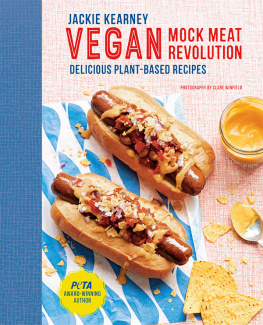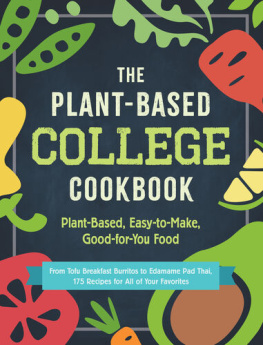

Text copyright 2016 Kris Holechek Peters. Design and concept copyright 2016 Ulysses Press and its licensors. All rights reserved. Any unauthorized duplication in whole or in part or dissemination of this edition by any means (including but not limited to photocopying, electronic devices, digital versions, and the Internet) will be prosecuted to the fullest extent of the law. Published in the United States by: Ulysses Press P.O. Box 3440 Berkeley, CA 94703 www.ulyssespress.com ISBN 13: 978-1-61243-615-9 Acquisitions editor: Casie Vogel Project editor: Alice Riegert Managing editor: Claire Chun Editor: Lauren Harrison Proofreader: Renee Rutledge Front cover design: Rebecca Lown Cover artwork: broccoli seitan stir-fry Peter Kim/shutterstock.com; red cup of food marco mayer/shutterstock.com; seitan, red peppers, and potatoes kitty/shutterstock.com Interior design: whatdesign @ whatweb.com Layout: Jake Flaherty Distributed by Publishers Group West IMPORTANT NOTE TO READERS: This book is independently authored and published and no sponsorship or endorsement of this book by, and no affiliation with, any trademarked brands or other products mentioned within is claimed or suggested.
All trademarks that appear in this book belong to their respective owners and are used here for informational purposes only. The authors and publisher encourage readers to patronize the quality brands and products mentioned in this book. To Jesse. Thanks for being the best culinary adventure companion and vegetable butcher I could ever ask for. Table of Contents
Guide
Contents This is not your grandmas wheat meat. Weve come such a long way in the world of meat substitutes that theyve largely become their own genre.
Seitan is a high-protein, versatile, magical substance that can take on many different textures and flavors. Whether you want to replicate an old meaty recipe from your past, make a meal that will please omnivores and herbivores alike, or just want to try something new and novelseitan is where its at. The recipes included in here run the gamut from basics that can act as a springboard for your own creations to new spins on old favorites. Whatever youre hankering for, this book is filled with hearty, mouthwatering fare that will incorporate new textures, exciting flavors, and more protein into your kitchen. Seitan has been around for a long time, but gained popularity in the U.S. in the 1970s as vegetarianism grew more widespread and people looked to the cuisines of other cultures for inspiration.
The history of wheat meat goes back over a millennium to China, where they mastered the art of alternative proteins (think mock duck)making seitan as old as some of the worlds largest religions. Its been around a while. Since the early days, faux meats have only increased in popularity, as more and more companies refine flavors and textures to make meat substitutes taste better and become more readily available. But you dont need to have a huge lab or commercial kitchen to make delicious meaty treats. You can partake in the history of seitans evolution with the recipes in this tasty tome using simple ingredients and your own kitchen. Oh My Gluten! It seems countercultural to be literally writing the book on gluten, doesnt it? Using the G-word has become close to swearing in our modern culture.
Why would someone write a book where its the main ingredient? Gluten has certainly gotten a lot of press in recent years, but its not new. Its the protein found naturally in wheat and some other grains. Its what binds our bread and makes seitan so toothsome and well-texturedand high in protein. Despite how often you hear about gluten intolerance and allergies, true gluten sensitivity is very rare. If you are someone who is affected, this is not the book for you. But, the overwhelming majority of people can tolerate gluten well.
Its not that gluten is some evil opponent; its a natural form of protein that exists in wheat. Too much of anythingsugar, fat, protein, saltis too much of a good thing. As with anything in life, all things in moderation. Seitan has been cooked and consumed for longer than any of us can imagine (over 1,500 years). Rest assured, cooking with it has withstood the test of time. If you have questions or concerns about gluten intolerance, please talk to a nutritional or medical professional.
Know Your Proteins There are a lot of different kinds of vegetarian proteins out there, and it can be confusing. Heres a breakdown to help clarify what youre eating: Tofu: Tofu is created by culturing soy milk, so the beans have been blended with water, liquefied, and then coagulated using one of several types of processes and enzymes. It comes in a variety of degrees of firmness and is sold as either silken tofu (which has a creamy texture, regardless of firmness) or standard tofu (which is typically water-packed and has a more curd-like texture than silken). Water-packed tofu should be drained and pressed before using to express any excess liquid, allowing it to absorb flavor and to cook better. Silken tofu should not be pressed, as its structure is too soft to withstand any pressure. Tempeh: Tempeh is also a soy product, but it uses the whole soybean, often including other grains or beans.
The resulting product is fermented and usually sold as a slab. On its own tempeh can have a bitter edge to its taste, which can be reduced or eliminated by letting it simmer a little in a small amount of water or by using a marinade. Tempeh has a nice, hearty texture and holds its shape well in cooking. TVP: TVP, or textured vegetable protein, is a product of soy, created by processing the beans. Its dried and needs to be reconstituted in liquid. Soy curls: Similar to TVP, but slightly less processed and in much larger chunks, soy curls must be reconstituted with liquid. Soy curls: Similar to TVP, but slightly less processed and in much larger chunks, soy curls must be reconstituted with liquid.
They make a good substitute for chicken and cook up easily. Commercially made fake meat: The secret sauce of these products (think veggie burgers, hot dogs, and the like) varies, but they are often soy based, using either TVP or tofu, with some added wheat gluten for texture. Seitan: In its most basic variation, seitan is wheat gluten with some seasoning and a little flour. Wheat gluten is now sold on its own by some specialty flour companies (like Bobs Red Mill), so you can easily acquire it. Wheat is made up of starch and proteinthe starch is stripped away, leaving just the protein, which is wheat gluten. In this book we make a variety of different types of seitan, many of which utilize other ingredients to enhance the flavor and texture.
All of the additional ingredients are easy to find and likely already live in your pantry. Pantry Here are some of the recommended ingredients and supplies to have on hand to turn your kitchen into a regular wheat gluten butchers shop! Vital wheat gluten flour: This is the basis upon which all faux meat depends. Well, seitan at least. You can get it in bulk at most co-ops and natural food stores, in addition to small bags/boxes from specialty flour companies. I recommend Bobs Red Mill or King Arthur Flour. Chickpea flour: This is used in small amounts in this book.
Buy it in bulka full-sized bag will last you a long while. Store unused chickpea flour in the freezer in a well-sealed container for up to 12 months. Spices and herbs:
- Fennel seeds
- Garlic powder











 Text copyright 2016 Kris Holechek Peters. Design and concept copyright 2016 Ulysses Press and its licensors. All rights reserved. Any unauthorized duplication in whole or in part or dissemination of this edition by any means (including but not limited to photocopying, electronic devices, digital versions, and the Internet) will be prosecuted to the fullest extent of the law. Published in the United States by: Ulysses Press P.O. Box 3440 Berkeley, CA 94703 www.ulyssespress.com ISBN 13: 978-1-61243-615-9 Acquisitions editor: Casie Vogel Project editor: Alice Riegert Managing editor: Claire Chun Editor: Lauren Harrison Proofreader: Renee Rutledge Front cover design: Rebecca Lown Cover artwork: broccoli seitan stir-fry Peter Kim/shutterstock.com; red cup of food marco mayer/shutterstock.com; seitan, red peppers, and potatoes kitty/shutterstock.com Interior design: whatdesign @ whatweb.com Layout: Jake Flaherty Distributed by Publishers Group West IMPORTANT NOTE TO READERS: This book is independently authored and published and no sponsorship or endorsement of this book by, and no affiliation with, any trademarked brands or other products mentioned within is claimed or suggested.
Text copyright 2016 Kris Holechek Peters. Design and concept copyright 2016 Ulysses Press and its licensors. All rights reserved. Any unauthorized duplication in whole or in part or dissemination of this edition by any means (including but not limited to photocopying, electronic devices, digital versions, and the Internet) will be prosecuted to the fullest extent of the law. Published in the United States by: Ulysses Press P.O. Box 3440 Berkeley, CA 94703 www.ulyssespress.com ISBN 13: 978-1-61243-615-9 Acquisitions editor: Casie Vogel Project editor: Alice Riegert Managing editor: Claire Chun Editor: Lauren Harrison Proofreader: Renee Rutledge Front cover design: Rebecca Lown Cover artwork: broccoli seitan stir-fry Peter Kim/shutterstock.com; red cup of food marco mayer/shutterstock.com; seitan, red peppers, and potatoes kitty/shutterstock.com Interior design: whatdesign @ whatweb.com Layout: Jake Flaherty Distributed by Publishers Group West IMPORTANT NOTE TO READERS: This book is independently authored and published and no sponsorship or endorsement of this book by, and no affiliation with, any trademarked brands or other products mentioned within is claimed or suggested.